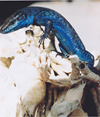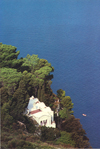 The Blue Grotto of Capri.
The Blue Grotto of Capri.It is a famous tourist attraction of Capri and it is the symbol of the island together with the "Faraglioni" rocks. Geologically the island of Capri is the continuation of the Sorrento Peninsula, which is 5 km (3 miles) away. The origin of its name comes from "kapros" which means a "boar", because of these animals so frequent on the isle. This place was inhabited since the Palaeolithic age when it was still linked to the mainland, but it was Greek and then Roman. In 29 b.C. the emperor Cesar Augustus visited Capri and he was struck by its beauty and bought it from the city of Neapolis (the ancient Naples) in exchange for the nearby isle of Ischia, which was larger and more fertile. His successor, Tiberius, lived there from 27 to 37 a.D. and he had twelve villas built : every villa was dedicated to a god. He ruled his huge Roman empire from Villa Jovis, whose ruins are still on the Tiberius Mountain.
 The Faraglioni rocks at the sunset
The Faraglioni rocks at the sunsetOn the famous rocks the rare species of blue lizard lives: it is unique in the world. The "Faraglioni Rocks", which are the symbol of the island, the main square "Piazza Umberto I", which has been called "the stage of the world" because a lot of famous personalities have been there, the "Gardens of Augustus", with their colourful flowers and nice sea-view, the "Blue Grotto", famous all over the world, make this island unique in the world.
 Camerelle street
Camerelle street "Via Camerelle" in Capri is certainly the most refined street of the island: it provides plenty of shops and boutiques of the Italian and international fashion.
The name of this way comes from the series of arches in bricks, so-called Camerelle, which supported in Roman times, probably, a road linking the villa of Tragara with that of Castiglione.
 Square Umberto I
Square Umberto IThe famous square "Umberto I" has been called "the stage of the world" because a lot of Italian and international celebrities come here every year.
Probably this square was the center of a very ancient colony, perhaps Phoenician: this is proved by the ruins (still visible near the terrace of the funicolar railway) of a big wall which once ran from Mount Saint Michael to Mount Castiglione.
Anyway, all around the square several buildings are in Norman style.
 The "Caprese": typical recipe of the island
The "Caprese": typical recipe of the island The "Caprese" is for sure the typical recipe of the island. Mozzarella and tomato create a splendid fusion effect but after centuries of indifference they have managed to celebrate their marriage only in the shadow of Vesuvius.
Food lovers can find them together in all seasons, when they are eaten fresh, barely cooked on pizza, or with "pasta alla sorrentina".
The reason of this love at first sight is very simple: the acid of the tomato, brought from the distant Americas, initially considered poisonous and then used as an ornamental plant, contrasts well with the fat in cheese, especially mozzarella cheese. In addition, the relaxing Mediterranean effect of basil satisfies the nose and makes this recipe noble.
 Blue Lizard
Blue LizardOn the symbol of the Capri island, the Faraglioni Rocks, the rare species of the blue lizard lives. It is unique in the world and it has a spectacular electric blue skin. Certainly, it comes from the ordinary lizard (Podarcis sicula ), so common on the island, and for some reason it managed to reach the "Faraglioni Rocks" and it has changed deeply. Surrounded by the sky and the ocean, it has camouflaged its skin in a very beautiful blue colour permanently. The scientific name of this animal is Lacerta Coerulea Faraglionensis.
 Axel Munthe Villa
Axel Munthe VillaThis image shows the Axel Munthe's house, which is nowadays a museum.
Axel Munthe was born on October 31st, 1857, in Oskarhamn in Sweden. He attended the schools in Sweden but, when he was only twenty-three years old he received his medical degree in Paris. He became physician-in-ordinary to Queen Victoria of Sweden in 1903.
He visited Capri for the first time in 1876 and he was struck by the beauty of this place: so he bought in Anacapri the ruins of the chapel of Saint Michael with a vineyard and a house in the middle which became his villa. Nowadays it is the Axel Munthe's museum.